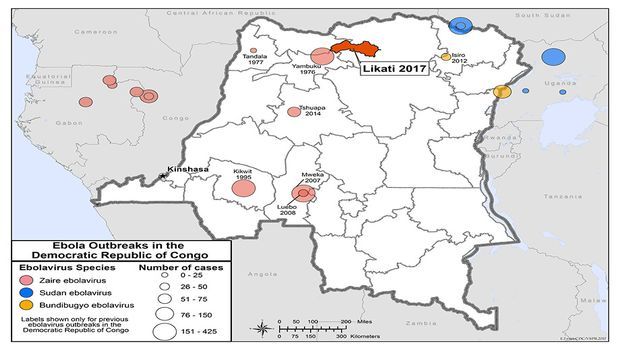CDC Offers Update on Cluster of Ebola Cases in Democratic Republic of the Congo

On May 11, 2017, the Ministry of Public Health of the Democratic Republic of the Congo notified international public health agencies of a cluster of suspected cases of Ebola Virus Disease (EVD) in the Likati health zone of the province of Bas Uélé. The report mentions nine cases, including two deaths, with a third death reported on May 12. Testing of samples was conducted by the Institut National de Recherche Biomedicale (INRB) in Kinshasa, with two samples testing positive for Ebola Zaire by RT-PCR. Teams from international agencies, including CDC, World Health Organization (WHO), MSF (Doctors without Borders), and others, are supporting the Ministry of Public Health’s epidemiologic, diagnostic, clinical, and communications efforts to respond to the outbreak. The response faces challenging logistical obstacles, including the remoteness of the area and limited services. Mobile diagnostic laboratories have been deployed to the affected areas.
Case Counts
As of May 20, 2017:
Total cases (suspect, probable or confirmed): 37 (12 in Nambwa, 4 in Muma, 16 in Ngayi, 3 in Azande, 2 in Ngabatala)
Laboratory-confirmed cases: 2
Deaths: 4
Contacts being followed: 362

The map shows the country of Democratic Republic of Congo, located in Cental Africa, and indicates outbreaks of Ebola that have happened there. The maps indicates outbreaks of Ebola in Yambuku in 1976, Tandala in 1977, Kikwit in 1995, Mweka in 2007, Luebo in 2008, Isiro in 2012, Tshuapa in 2014, and, presently, in Likati in 2017. All outbreaks were of the Ebola Zaire subtype, except for the Isiro outbreak, with Ebola Bundibugyo. All outbreaks of Ebola Zaire were between 51-75 cases; the Isiro outbreak was from 26 to 50 cases.
Source: CDC
Robust infectious disease surveillance, including rapid subtyping of influenza A, is essential for early detection, containment, and public health reporting of novel viral threats.